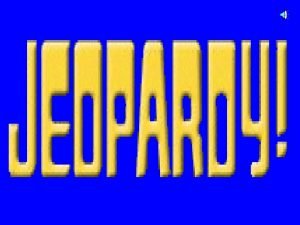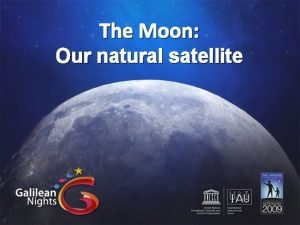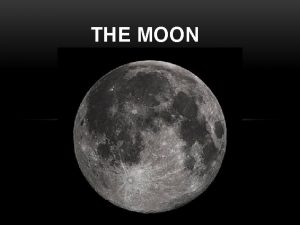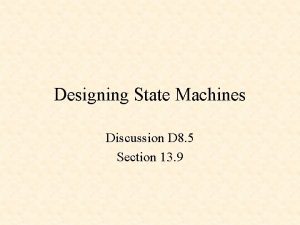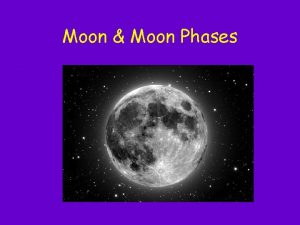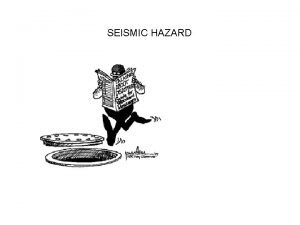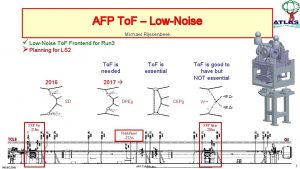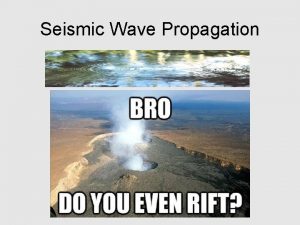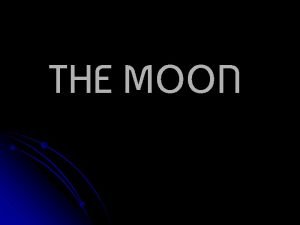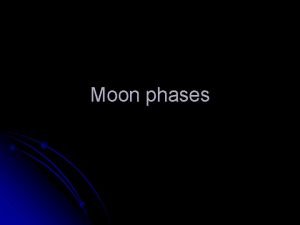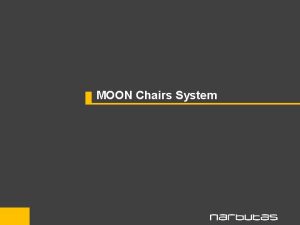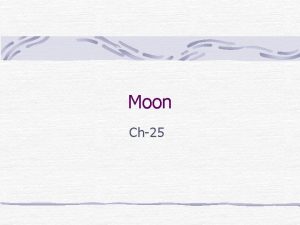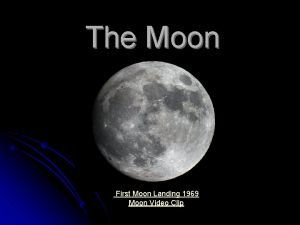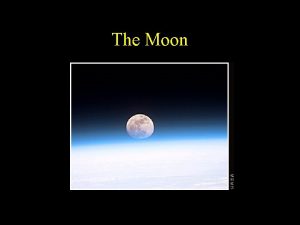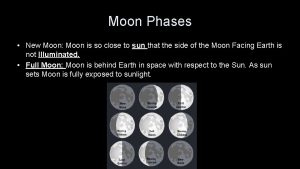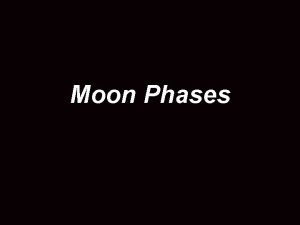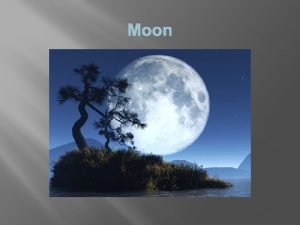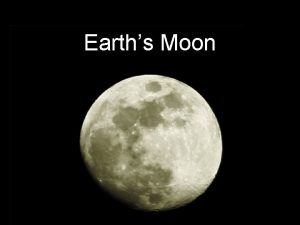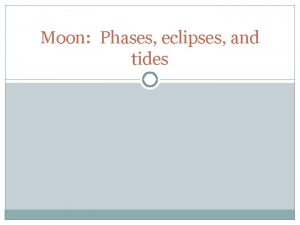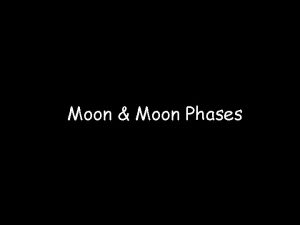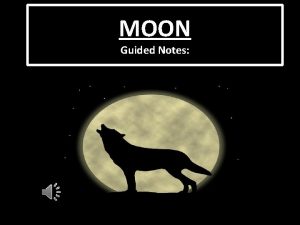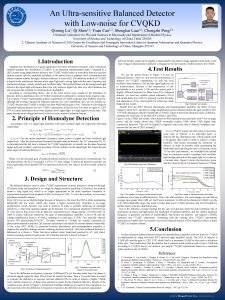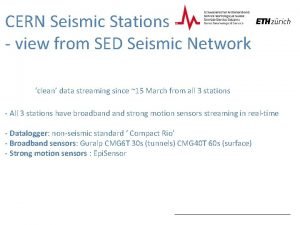Using the Moon as a LowNoise Seismic Detector




































- Slides: 36

Using the Moon as a Low-Noise Seismic Detector for Strange Quark Nuggets (SQNs) Talso Chui Jet Propulsion Laboratory California Institute of Technology Collaborations Geology, Seismology & Lunar Science: Bruce Banerdt (JPL), Eugene Herrin (SMU), Yosio Nakamura (U. Texas) Particle Astrophysics: Vigdor Teplitz (SMU & GSFC), Doris Rosenbaum (SMU) Instrument Physics: Ho Jung Paik (UM), Konstantin Penanen (JPL), Joseph Young (JPL) Third International Conference on Particle and Fundamental Physics in Space April 21, 2006, Beijing, China. 1

Introduction, Motivations & Outline • NASA’s Vision for Exploration: “Use lunar exploration activities to further science” • Motivated by valuable opportunities to conduct science research on the Moon. • Unique lunar environment – very quiet seismically. • Proposal: Deploy an array of sensitive seismometers to measure seismic signals below the sensitivity limit of Apollo seismometers. • Small lunar seismic signals contain information on: — Particle Astrophysics: strange quark matter abundance. — Lunar Science: structure & evolution of the Moon. • Science rationale for lunar SQN searches. • Review of previous and on-going SQN searches. • Detection schemes. • New technologies for measuring small seismic signals. • Conclusion 2

Lunar Seismic Search for Strange Quark Nuggets (SQNs) • Strange Quark Matter is a very dense form of matter, postulated by Witten (1984). Consists of up, down and strange quarks. Ordinary matter made of protons and neutrons consists of up and down quarks. Interior of neutron stars possibly made of Strange Quark Matter, not neutrons. Expelled into the Universe as debris from neutron stars collisions. May also be produced in early universe, well before cosmic nucleosynthesis – an interesting candidate for cold dark matter. • A micron-sized SQN would weigh in the ton range. A massive SQN could pass through the Earth and generate a trail of seismic waves (de Rujula and Glashow, 1984). Lower seismic activity on the Moon enhances detection probability. • Deploy one or more seismometers on the Moon to detect SQN transit. No other known way to search for SQN in mass range of 1 -106 g. 3

Lunar Seismic Data • • 10 million times less seismic energy: Earth ~1017– 1018 J/yr Mars ~1014 J/yr (predicted). Moon ~2 x 1010 J/yr Pre-dawn seismic data are most quiet – limited by Apollo instrument resolution. 4

Properties Strange Quark Matter • • Charge qu=+2/3, qd=-1/3, qs=-1/3. Ordinary nuclei are made of neutrons and protons. Large nuclei have higher charge, large Coulomb repulsion. Very large nuclei break up due to Coulomb force. Strange Quark Matter can form large nuggets. SQNs are nearly charge neutral, small Coulomb repulsion. Less Pauli Exclusion Principle repulsion due to three species rather than two. • Unknown if SQN is stable under zero pressure. • Under sufficient pressure, Strange Quark Matter is thought to be stable, possibly inside neutron stars. • “Color-flavor locking” in SQN should produce Cooper pairs. Color Superconductivity favors SQN stability. [Alford, M. , Rajagopal, K. and Wilczek, F. QCD at finite baryon density: nucleon droplets and color superconductivity. Phys. Lett. B 422, 247, 1998. ] Angstrom-Size Electron Cloud + Charged SQN: Z ~ (1/3)A 1/3. Nuclei: Z ~ A/2. 5

Science Questions Microwave Sky Image from WMAP Fit to theory Energy contents of the Universe Do SQNs exist? Are there enough to account for Cold Dark Matter? 6

Science Rationale • Explore physics in an area where string theory gives exciting quantitative results. Success of string theory as an alternative to QCD Masses, decay rates and coupling of light mesons • Search for relics of the Big Bang, formed at energies far beyond what can be produced in any present or future ground-based accelerator. • Results will complement the Inflation Probe, and space gravitational lensing astronomy – SNAP/JDEM, DUNE, HST. • Complement results of RHIC. • Search in unique parameter space. [J. Erlich et al. , PRL 95, 161602, 2005] Son, D. T. & Starinets computed thermal and transport coefficients. May be applicable to QGP [http: //arxiv. org/abs/hep-th/0601157, 2006] 7

Review of Previous Search r. DM = 0. 4 Gev/cm 3 = 7 x 10 -25 g/cm 3. The Moon is Large and Quiet u = virial velocity = 230 km/s. m = mass of SQN. Flux = (cm-2 s-1 sr-1) 8

An SQN Passage Seismic Event Moonquake and Meteorite Impact SQN velocity = virial velocity SQN transit = 230 km/s Seismic wave velocity ~ 6 – 10 km/s Characteristics: • Linear seismic events. • Shockwave, like “Sonic Boom”. • Primordial SQN has narrow mass distribution. 9

Seismic Energy Release Estimates u = virial velocity = 230 km/s. s = cross-section area of an SQN. r. E = mean density of Earth. dm/dt = r. E u s = rate of mass removal. d. E/dm = u 2/2 = Energy for changing the velocity of the removed mass to u. 2 f = fraction of energy loss converted to seismic waves. d. Eseismic/dt = f (d. E/dm) (dm/dt) = f r. E u 3 s. 2 f = 1% for underground nuclear explosion. 2 f = 2% for underground chemical explosion. Analogous to bullet thru apple. Mostly compression waves. 2 f = 5% for SQN passage (estimated). Less energy goes into breaking rocks. 10

Detection Schemes #1 Look for linear seismic events • • • Measure seismic-waves arrival times. Six seismic stations needed to solve for six unknowns – entry longitude and latitude, exit longitude and latitude, time of entry, speed of SQN. International Lunar Seismic Network? – • • Possible lunar landing – USA, China, Japan, Europe, Russia, India. Spread the seismic stations as far away from each other as possible. Arrival times of shear waves and compression waves may give additional info on distance to point of closes approach, reducing error. 11

Detection Schemes #1 Look for linear seismic events International Lunar Seismic Network – Six seismic stations 12

Hypothetical Example Primordial SQN of 104 gm. Diameter = 5. 7 mm. s = 2. 6 x 10 -7 cm 2. Flux = 10 -22 (cm-2 s-1 sr-1) No = Lunar transit rate = 1/(2. 3 hr) = 3800/yr. d. E/dt = 5. 3 x 107 J/s. Eo = Max. seismic energy deposited = 8 x 108 J. t. SQN = Max. transit time = 15 s. 13

Detection Schemes #2 Cumulative Event Rate Plot • • • Requires only one seismometer. Filter out thermal moonquakes - >300, 000 during Apollo. Remove events with characteristics of: – – – • Primordial SQNs should have narrow mass and velocity distribution. – • • • Short duration. Little energy below 1 Hz. Occurring at periods of large temperature changes d. N/d. E E Log (N) N= Event Rate with energy >E Lots of seismic events of a certain size. Plot cumulative # of events with energy > E versus E. Requirement: Noise in N, DN < No Not sensitive to SQN from collisions of compact stars. Approximate the Moon as an energy integrator Primordial SQN No Meteorites DN Earth’s Noise Eo/2 Eo Log (E) E = Seismic Energy threshold 14

Seismology on the Moon Four types of seismic events 1 8 -year Apollo Program: 1969 - 1977 Number Detected 4 2 7245 3 28 1743 Thermal Moonquake: Thermally induced, nearby sources, high frequency contents, not correlated with other seismic stations, most prominent in SPZ seismometers. Number Detected > 300, 000. Must be filtered out. C. Neal, LEAG 2005 Conf. 5 6 Unclassified: 3243 Total – Thermal quakes: 12, 259 events 15

Detection Schemes #2 Event Rate Plot N ~ 1/E E ~ s ~ m 2/3 DN ~ N 1/2 ~ m -1/3 Single Seismometer using Event Rate Plot Detection Hypothetical example event rate No = 3800 events/year. Apollo seismic event rate, N = 12, 259/8 = 1, 532 events/year. DN ~ N 1/2 = (1, 532)1/2 = 39 events/year. Satisfy: DN < No 16

Detection Schemes #3 Unique Waveform? 1. 2. 3. 4. “Sonic Boom” like source. Strong scattering at lunar crust (30 – 60 km) may diffuse out this unique feature. Linear “Sonic Boom” sources may still have unique features in waveform and frequency spectrum that are preserved through lunar crust. Speculation: There may be places where the mantle could have been exposed. Sonic boom waveform Glushko crater ~43 km (SMART-1 Mission) Aitkin Basin ~2000 km Looking for exposed mantle 5. Need more work. (Clementine Mission) 17

A Puzzling New Observation Extra-Solar-System Origin of Moonquakes? Nakamura, Y. and Frohlich C. , Possible extra-solar-system cause for certain lunar seismic events, Lunar & Planetary Science XXXVII, 1048, 2006. • Out of 28 Shallow Moonquakes 23 of them occurred when lunar nearside was facing the Virgo Constellation. • If not a coincident, then a groundbreaking astrophysical observation. • Strange Quark Nuggets? • Other yet to be discovered massive particles? • Sensitive seismometer needed for further studies. Virgo Constellation 18

Lunar Science • SQN search requires knowledge of the structure and composition of the Moon for seismic modeling. • Structure and composition of the Moon need better characterization. • The state of the lunar core needs better definition. • Limited knowledge on far-side seismicity. • Limited knowledge on seismicity at polar regions. • Fundamental oscillation modes of the Moon not yet measured. • An array of sensitive seismometers can provide answers. 19

Conclusion • NASA’s Vision for Exploration will offer valuable opportunities to conduct science on the Moon. • Unique lunar environment – Very Quiet Seismically. • Need to develop sensitive seismometers to make use of the environment. • Small lunar seismic signals contain scientific information: – SQN abundance. – Structure and evolution of the Moon and the Solar System. • If SQN is found: – Change our view of the Universe and the matter in it. – Solve the dark matter problem. • If SQN is not found – establish new limit on its abundance. • Proposed research will enrich the science content of international lunar exploration programs and inspire the public. • Proposal will promote international collaboration. 20

International Lunar Seismic Network (ILSN) International Collaboration Required 21

Backup charts Konstantin will talk on the seismometer right after my talk. 22

Seismometer Concept (Contributed by Prof. Ho Jung Paik, UM) • Pendulum natural frequency = fo = 0. 4 Hz on the Moon • Two pairs of capacitors for displacement measurement. • Two pairs of capacitors for applying DC voltage to reduce fo and to balance tilt. • Why reduce fo ? • Thermal noise of seismometer: y x Cylindrical Test Mass Capacitor Plates CN 1 CN 4 Cross Section View CN 3 CN 2 • Target: Q = 104, fo= 0. 01 Hz, m = 0. 27 kg. 23

Seismometer Fabrication (Contributed by Prof. Ho Jung Paik, UM) Seismometer Housing Seismometer Capacitor Plates Q = 4000. Frequency reduced from 1 Hz to 0. 35 Hz. 24

Seismometer Electronics Concept: A Concept: B Based on 0. 001 ppm tunnel-diode oscillator [C. T. Van Degrift, Rev. Sci. Instrum. 46, 599 (1975). ] X • Used by LISA. • LISA measurement scales to 10 -14 m-Hz-1/2 in x for x = 10 -4 m. Tunnel Diode [W. J. Weber et al. , Class. and Quantum Grav. 19, 1751, 2002. ] A circuit board with two tunnel-diode oscillator circuits. It was populated with only one tunnel-diode for testing. 25

Seismometer Based on Tunnel-Diode Oscillators • Operates at wide temp. range: 400 K to 1 K. • Use very low power: <10 m. W. • Suitable for operation thru lunar night. • A 5 kg Lithium Ion can supply 1 W through lunar night. • Radioisotope Heater Unit (RHU) to keep electronics warm. y z TD OSC 1 TD OSC 2 Test Mass out Mixer LPF out y Buffer Amp x=z-y Counter Computer Seismometer based on tunnel-diode oscillator. 26

Tunnel-Diode Oscillator Evaluation (Contributed by Joseph Young) Square-root of the Allan variance s. A Aeroflex/Metelics MBD 1057 -H 20 tunnel diode (modern part) Thermal Noise Limit: Thermal Noise + Shot Noise density 27

Tunnel-Diode Oscillator Evaluation (Contributed by Joseph Young) Relative freq. change of a 10 MHz Oscillator versus Temp. 290 K 77 K 4. 2 K Change 0% +1. 6% +3. 7% Operates from 300 K to 4 K without adjustment Thermal Cycles: 20 times to 77 K 6 times to 4 K Continuously operated over 1 month. 28

Expected Seismometer Displacement Noise Density Sy( f )1/2 Apollo Seismometers Thermal Noise of Test Mass Tunnel-Diode Oscillator Noise Bridge Circuit, 15 V drive 29

SQN search could make use of lunar exploration capabilities Dan Lester’s presentation at LEAG conference 2005 • . 30

Review of Previous SQN Searches Particle Detectors SQNs have high mass (A) to charge (Z) ratio. Nuclei in periodic table A/Z < 3. 1. HECRO-81 – A balloon flight Cherenkov counter. Observed two events with A=110 – 370 emu, Z = 14. A/Z ~ 7. 8. [Saito, T. , Hatano, Y. , Fukada, Y. and Oda, H. Phys. Rev. Lett. 65, 2094, 1990. ] 2. Monopole - a stack of Lexan track detectors and nuclear emulsions. Observed an event with A > 103 – 104 emu, Z = 45. Initially thought to be a monopole. [Price, P. B. . , Shirk, E. K. , Osborne, W. Z. and Pinsky, L. S. Phys. Rev. D 18, 3813, 1988. ] 3. Alpha Magnetic Spectrometer (AMS) to be flown on the ISS. ~ 1 m 2 crosssection. [PI – Sam Ting, MIT] SQN: Z ~ (1/3)A 1/3. Nuclei: Z ~ A/2. 31

Review of Previous SQN Searches Lunar Soil Samples Lighter SQNs in cosmic rays may have been captured by soil. Lunar soil is not as disturbed by geological processes. SQN is at a lower energy state. An ion beam may overcome Coulomb barrier, and fuse with SQNs, releasing potential energy in the form of g-rays. [Farhi, E. and Jaffe, R. L. Phys Rev. D 32, 2452, 1985. ] No g-rays were observed. [Perillo Isaac M. C. et al. Search for strange matter by heavy ion activation. Phys. Rev. Lett. 81, 2416, 1989. ] 32

Review of Previous SQN Searches Track Damage Cosmic rays leave damaged tracks in solid materials. So does a SQN. Mica buried in deep mines was examined for track damage. Very sensitive due to long geological time (~108 years) of exposure. Other synthetic materials were also used for short exposure on mountain top, at sea level and onboard Skylab. Price, P. B. . Phys. Rev. D 38, 3813, 1988. Shirk, E. K. and Price P. B. Astrophys. J. 220, 719, 1978. Barwick, S. W. , Kinoshita, K. and Price B. P. Phys. Rev D 28, 2338, 1983. Doke, T. , Hayashi, T. , Hamasaki, R. , Akioka, T. , Naito, T. , Ito, K. , Yanagimachi, T. , Kobayashi, S. , Takenaka, T. , Ohe, M. , Nagata, K. and Takahashi, T. Phys. Rev. B 129, 370, 1983. Price, B. P. and Salamon, M. H. Phys. Rev. Lett. 56, 1226, 1986. Orito. , S. et al. . Phys. Rev. Lett. 66, 1951, 1991. 33

Review of Previous SQN Searches Earthquake Detection Detect seismic energy release due to SQN passage. d. Eseismic/dt = f r. E u 3 s. Searched for linear seismic events from six or more seismic stations. One event was originally reported. But the clock in a seismic station was found to be off by 9 s during the month of the measurement. Therefore no SQN transit was detected. [Anderson, D. P. , Herrin, E. T. , Teplitz, V. L. and Tibuleac, I. M. Bull. Seis. Soc. of Am. 93, 2363, 2003. ] [Selby, N. D. , Young, J. B. and Douglas, A. Bull. Seis. Soc. Am. 94, 2414, 2004. ] [Herrin, E. T. , Rosenbaum, D. C. and Teplitz, V. L. Seismic Search for Strange Quark Nuggets. Phys. Rev. D 73, 043511 (2006)] 34

Event Rate Plot for Hypothetical Example t. SQN = max. transit time = 15 s. tseismic = time for waves to travel the diameter =20 min. Approximate the Moon as seismic energy integrator. N(r)/No tring = seismic ring-down time = 15 min. Measures total seismic energy deposited. R = radius of the Moon = 1750 km. E(r)/Eo N(r) = Nor 2/R 2. E(r) = Eo[1 – (r/R)2]1/2 r R 35

Critics of Strange Quark Matter Theory 1. Pulsar glitch too large for strange star. • • DW/W = Icrust /I = 10 -2 -10 -3, agrees with neutron star model. • • DW/W = 10 -5 for strange star. [M. A. Alpar, PRL 58, 2152, 1987. ] • But, strange star may be solid. [A. Z. Zhou et al. Astroparticle Phys. 22, 73, 2004. ] Quark Gluon Plasma 2. Primordial SQN may cool by evaporating or boiling into hadrons. (QGP) [S. J. Cho et al. , Phys. Rev. D 50, 4771, 1994] • But, evaporation/boiling rate may be small. [M. L. Olesen and J. Madsen, Phys. Rev. D, 2313, 1993. ] • Equation of State not well known. • String theory may come to the rescue. [J. Erlich et al. , PRL 95, 161602, 2005. R. Da Rold and A. Pomarol, Nucl. Phys. B 721, 79, 2005. ] QGP T ~ 176 Mev ~ 1012 K hadrons Time ~ 10 -6 s SQN Cooling by evaporation into hadrons 36
 Which moon phase occurs directly before a new moon
Which moon phase occurs directly before a new moon Moon sister moon calendar
Moon sister moon calendar Home.hiwaay.net/ krcool/astro/moon/moon tides/
Home.hiwaay.net/ krcool/astro/moon/moon tides/ The science duo
The science duo What phase is this
What phase is this Sequence detector 1101
Sequence detector 1101 Khi nào hổ con có thể sống độc lập
Khi nào hổ con có thể sống độc lập Thế nào là mạng điện lắp đặt kiểu nổi
Thế nào là mạng điện lắp đặt kiểu nổi Dạng đột biến một nhiễm là
Dạng đột biến một nhiễm là Vẽ hình chiếu đứng bằng cạnh của vật thể
Vẽ hình chiếu đứng bằng cạnh của vật thể Bổ thể
Bổ thể Thế nào là sự mỏi cơ
Thế nào là sự mỏi cơ độ dài liên kết
độ dài liên kết Thiếu nhi thế giới liên hoan
Thiếu nhi thế giới liên hoan Alleluia hat len nguoi oi
Alleluia hat len nguoi oi điện thế nghỉ
điện thế nghỉ Một số thể thơ truyền thống
Một số thể thơ truyền thống Trời xanh đây là của chúng ta thể thơ
Trời xanh đây là của chúng ta thể thơ Số.nguyên tố
Số.nguyên tố đặc điểm cơ thể của người tối cổ
đặc điểm cơ thể của người tối cổ Vẽ hình chiếu vuông góc của vật thể sau
Vẽ hình chiếu vuông góc của vật thể sau Tỉ lệ cơ thể trẻ em
Tỉ lệ cơ thể trẻ em Các châu lục và đại dương trên thế giới
Các châu lục và đại dương trên thế giới ưu thế lai là gì
ưu thế lai là gì Sơ đồ cơ thể người
Sơ đồ cơ thể người Tư thế ngồi viết
Tư thế ngồi viết Các môn thể thao bắt đầu bằng từ đua
Các môn thể thao bắt đầu bằng từ đua Hình ảnh bộ gõ cơ thể búng tay
Hình ảnh bộ gõ cơ thể búng tay Cái miệng bé xinh thế chỉ nói điều hay thôi
Cái miệng bé xinh thế chỉ nói điều hay thôi Mật thư tọa độ 5x5
Mật thư tọa độ 5x5 Tư thế ngồi viết
Tư thế ngồi viết Ví dụ giọng cùng tên
Ví dụ giọng cùng tên Thẻ vin
Thẻ vin Gấu đi như thế nào
Gấu đi như thế nào Thể thơ truyền thống
Thể thơ truyền thống Các châu lục và đại dương trên thế giới
Các châu lục và đại dương trên thế giới Sự nuôi và dạy con của hổ
Sự nuôi và dạy con của hổ
